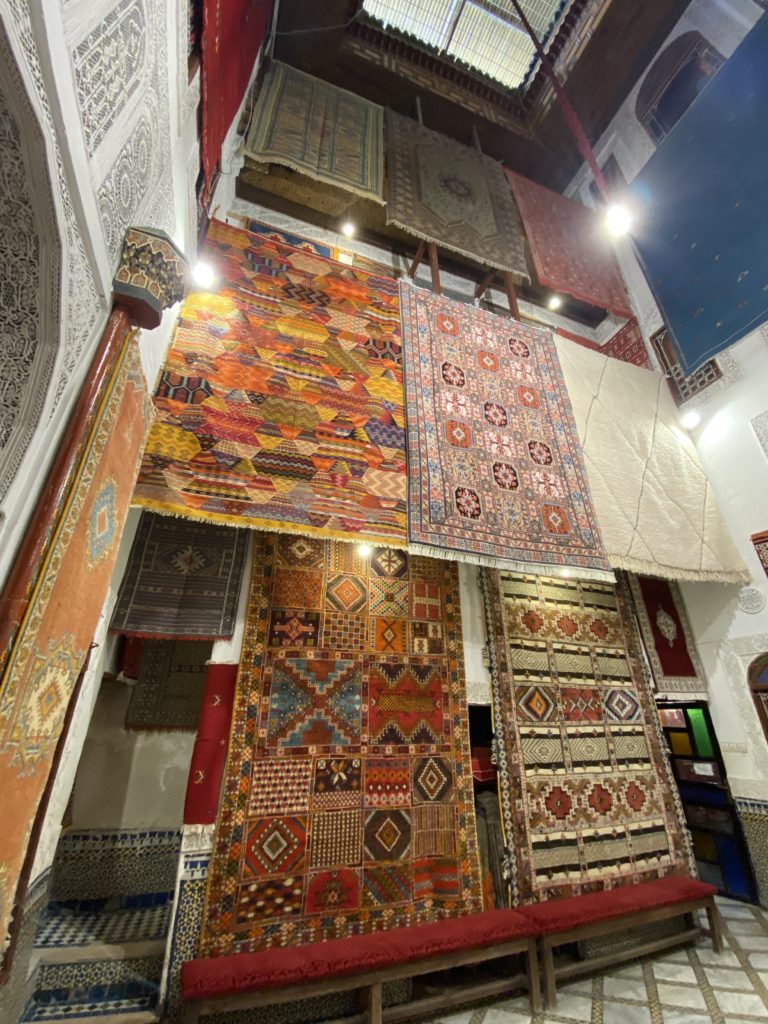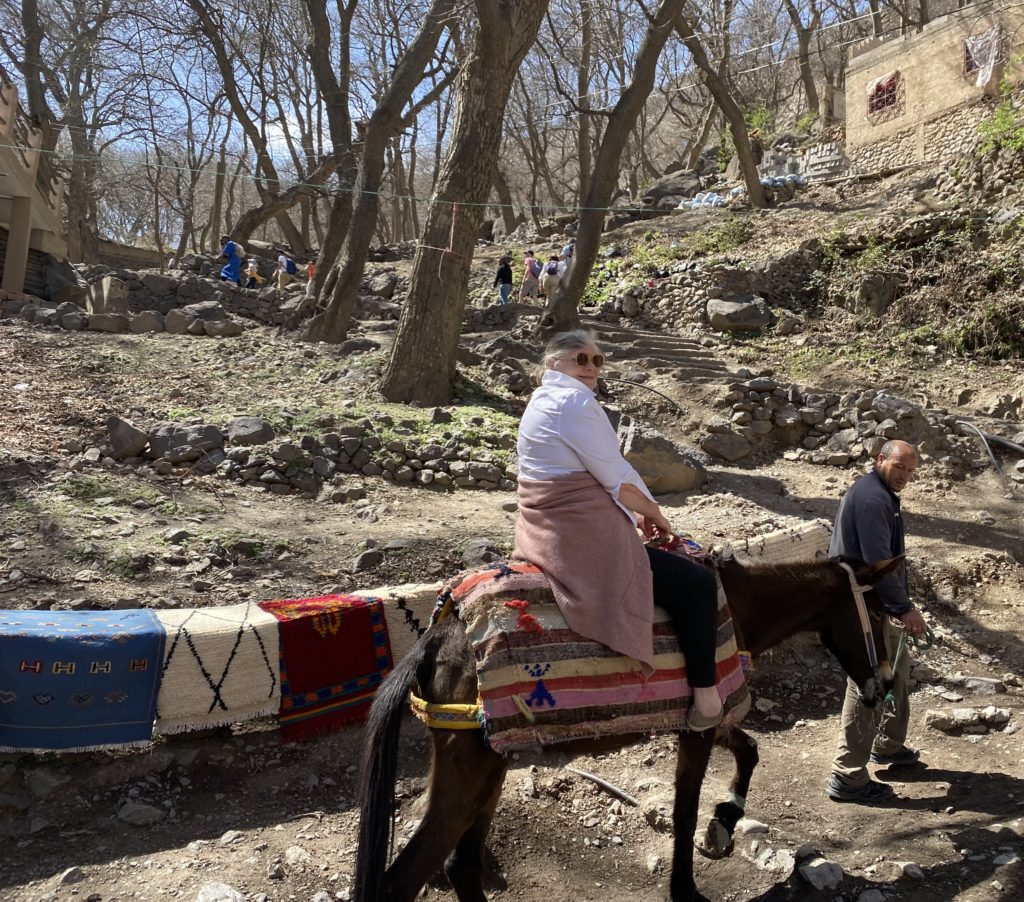
By P. F. Sommerfeldt –
I know how lucky I am, having just returned from a fabulous tour of Morocco, exploring Rabat, Fes, Meknes, Arfoud, Merzouga, Toubkal and Marrakesh (March, 2023), staying in wonderful riads and scouring three medinas (Rabat, Fes, Marrakesh) for exotic items generally unavailable in San Francisco and walking through several open-air souks including in Ksar Ait Benhaddou. I even rode a camel in the sand dunes of the Sahara and slept in a tent there and also rode a donkey up to the Toubkal Casbah below Mt. Toubkal in the High Atlas Mountains. It was magical and a dream come true.
The Berbers have been around for millennia, especially in the Atlas mountains regions and long before Arabs brought Islam in the 8th c. CE. The indigenous Berber demography of Morocco is almost a third of the population at around 13 million – and they are a vibrant community, thanks in part to the enlightened monarchy of the Alawi dynasty and the current King Muhammad VI. It is easy now to see the Berber alphabetic language written on a majority of signs around Morocco thanks to a revival and high valuation of Berber heritage. One Berber title for themselves is the Amazigh or “Free People” (technically “Free Man”) and the Berber alphabet and language is the Tamazight, which one can hear all over Morocco. In fact, in Imlil just below Mt. Toubkal in the High Atlas Mountains, I was told my mule only understood Berber Tamazight, not Arabic since the Atlas Mountain population is mostly Berber.

I also admit I have a lifelong penchant for Near Eastern style rugs, having searched and purchased them in Turkey, Tunisia and now Morocco, where Berber rugs have been a fascinating cultural display of values and aesthetics for millennia. My husband didn’t need to get me hooked on them from his own explorations in Egypt, Jordan, Turkey and Iran where he brought back exotic rugs from various cultural diplomacy trips. When we lived in London we purchased Afghani rugs from Liberty and local shops. On this recent trip I even visited several Berber Museums including in the Majorelle Garden of Marrakesh.

While I must have looked closely at over a hundred Berber rugs across Morocco, a few were so compelling I now have several of them in my home. I looked at many rugs from the back of a mule between Imlil and the Toubkal Casbah in the High Atlas, and it’s a first for me that I haggled for and purchased one rug entirely from the back of a mule, since getting on and off wasn’t as easy for me and the Berber merchant was happy to accommodate me on muleback.

The immediate above photo is of the historic Ksar Ait Benhaddou, a caravanserie stop on the route from the Sahara to Marrakesh, fortified since the 11th century by he Almoravids and a UNESCO heritage site since 1987. Perhaps more interesting to fans of cinema is that is featured in many films, including Gladiator (2000, a temporary amphitheater set was constructed on the south side of the site) and the brilliant and enigmatic moviemaker Terry Gilliam selected it as the city of Agamemnon in Time Bandits (1981) where you can watch King Agamemnon (Sean Connery) and young Kevin (Craig Warnock) ride across the desert to this incredibly picturesque place.

In the Ksar Ait Benhaddou, some local Berbers have their own home rug industry and women weave them on personal looms. Although the large cities like Fes and Marrakesh can collect Berber rugs from all over the country, each region of Morocco has its own local rug patterns and traditions, and sometimes you can only find certain rugs in specific places.

In Imlil in the High Atlas Mountains, Berber open air souks offer a wide range of Toubkal rugs all the way to the upper casbah, as seen some of the accompanying photos. The rugs in the mountain villages and souks tend to have better prices than in the big cities. Many of the dyes in rural areas are organic, such as indigo and madder or mineral-based like copper, sulfur and iron. This is not always the case in the cities where aniline and chemical dyes are more ready available.

According to Moroccan rug historians like Bruno Barbatti or Gebhart Blazek, the Moroccan Berber rug patterns often tell stories or have a strong narrative symbolism, such as the Amazigh symbol of freedom, which looks like a mirrored Greek psi human stick figure, a symbol often also seen painted on the mountains or made with painted rocks, or below on a doorway.

The weaving pattern is often a simple loop pile weave and the best carpets are made of wool from sheep or gats, but also including camel, which may be the most durable. One rug I fell in love with and now have at home in my office (see the rich multi-colored lead image above at the top of this article) has strong associations with both the visualized peaks of the Atlas Mountains in all their mineral hues, the stunning blue sky and the Sahara sand dunes and it also reminds me of the rose-colored sand dunes of Merzouga where I stayed in a tent. Such rugs will always remind me of my dreamy time in Morocco.


The rug I purchased on muleback above Imlil on the way to Toubkal Casbah is incredibly durable and with its brown rectangle on an indigo blue field is perfect for my home’s ground-floor hallway.

